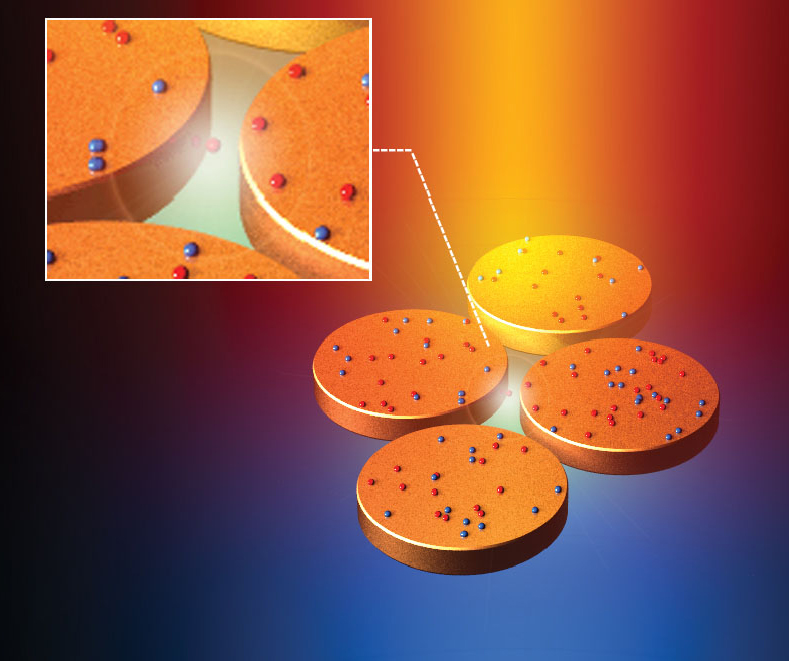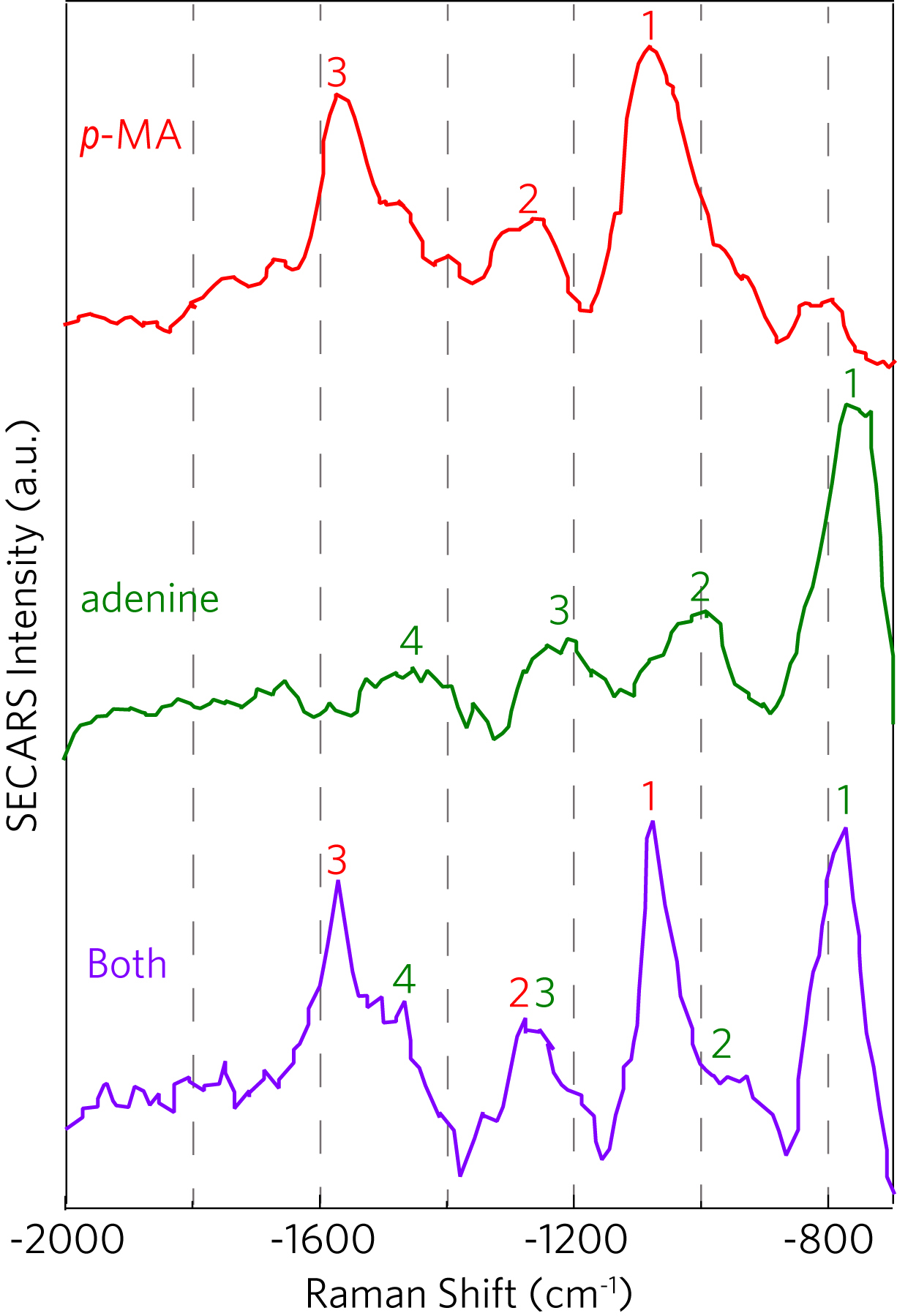Powerful new sensor identfies molecules containing fewer than 20 atoms
July 21, 2014

Rice’s SECARS molecular sensor contains an optical amplifier made of four gold discs arranged in a diamond-shaped pattern. A two-coherent-laser setup amplifies the optical signatures of molecules in the center of the structure as much as 100 billion times. (Credit: Y. Zhang/Rice University)
Researchers at Rice University’s Laboratory for Nanophotonics (LANP) have created a unique sensor that amplifies the optical signature of molecules by about 100 billion times — accurately identifying the composition and structure of individual molecules containing fewer than 20 atoms.
The new single-molecule imaging method, described in the journal Nature Communications, uses a form of Raman spectroscopy in combination with optical amplifier, making the sensor about 10 times more powerful that previously reported devices, said LANP Director Naomi Halas, the lead scientist on the study.
“The ideal single-molecule sensor would be able to identify an unknown molecule — even a very small one — without any prior information about that molecule’s structure or composition. That’s not possible with current technology, but this new technique has that potential.”
Boosting faint signals with ‘surface-enhanced CARS’
The optical sensor uses Raman spectroscopy, a technique pioneered in the 1930s that blossomed after the advent of lasers in the 1960s. When light strikes a molecule, most of its photons bounce off or pass directly through, but a tiny fraction — fewer than one in a trillion — are absorbed and re-emitted into another energy level that differs from their initial level. By measuring and analyzing these re-emitted photons through Raman spectroscopy, scientists can decipher the types of atoms in a molecule as well as their structural arrangement.
Scientists have created a number of techniques to boost Raman signals. In the new study, LANP graduate student Yu Zhang used one of these, a two-coherent-laser technique called “coherent anti-Stokes Raman spectroscopy,” or CARS. By using CARS in conjunction with a light amplifier made of four tiny gold nanodiscs, Halas and Zhang were able to measure single molecules in a powerful new way. LANP has dubbed the new technique “surface-enhanced CARS,” or SECARS.

Detected SECARS signals from a single molecule (p-MA: 4-aminothiophenol, and adenine), and from 2 molecules (mixture of 1 p-MA and 1 adenine) (credit: Yu Zhang/Rice University)
“The two-coherent-laser setup in SECARS is important because the second laser provides further amplification,” Zhang said.
“In a conventional single-laser setup, photons go through two steps of absorption and re-emission, and the optical signatures are usually amplified around 100 million to 10 billion times. By adding a second laser that is coherent with the first one, the SECARS technique employs a more complex multiphoton process.”
Zhang said the additional amplification gives SECARS the potential to address most unknown samples. That’s an added advantage over current techniques for single-molecule sensing, which generally require a prior knowledge about a molecule’s resonant frequency before it can be accurately measured.
Optical amplifier
Another key component of the SECARS process is the device’s optical amplifier, which contains four tiny gold discs in a precise diamond-shaped arrangement.
The gap in the center of the four discs is about 15 nanometers wide. Owing to an optical effect called a “Fano resonance,” the optical signatures of molecules caught in that gap are dramatically amplified because of the efficient light harvesting and signal scattering properties of the four-disc structure.
“Amplification is important for sensing small molecules because the smaller the molecule, the weaker the optical signature,” Halas said. “This amplification method is the most powerful yet demonstrated, and it could prove useful in experiments where existing techniques can’t provide reliable data.”
Widespread uses; devices to be available with the year
LANP graduate student Yu Zhang told KurzweilAI in an email that the new molecule-sensor could be widely used anywhere sensitive chemical-composition analysis is needed, such as non-invasive investigation of archaeological materials, identification of pharmaceutical ingredients, environmental pollutant analysis, and detection of extremely low concentrated abused drugs in saliva.
“It could instantly diagnose some diseases based on just one drop of blood on the optical amplifier, in a very sensitive and accurate manner. For homeland security, it could be an effective technique to detect explosives with very fast speed (within around 1 second) and high accuracy (reduced false rates).
“The SECARS sensor could obtain the analysis results in a few seconds. In comparison, sensors using a technique called surface-enhanced Raman spectroscopy (SERS) usually obtain results in minutes; sensors using surface-enhanced infrared absorption (SEIRA) technique may obtain results in as long as a few hours.”
Zhang said devices based on the new sensor will be commercially available in the coming year.
The research was supported by the Department of Defense, the Defense Threat Reduction Agency. and the Robert A. Welch Foundation.
Abstract of Nature Communications paper
Plasmonic nanostructures are of particular interest as substrates for the spectroscopic detection and identification of individual molecules. Single-molecule sensitivity Raman detection has been achieved by combining resonant molecular excitation with large electromagnetic field enhancements experienced by a molecule associated with an interparticle junction. Detection of molecules with extremely small Raman cross-sections (~10−30 cm2 sr−1), however, has remained elusive. Here we show that coherent anti-Stokes Raman spectroscopy (CARS), a nonlinear spectroscopy of great utility and potential for molecular sensing, can be used to obtain single-molecule detection sensitivity, by exploiting the unique light harvesting properties of plasmonic Fano resonances. The CARS signal is enhanced by ~11 orders of magnitude relative to spontaneous Raman scattering, enabling the detection of single molecules, which is verified using a statistically rigorous bi-analyte method. This approach combines unprecedented single-molecule spectral sensitivity with plasmonic substrates that can be fabricated using top-down lithographic strategies.